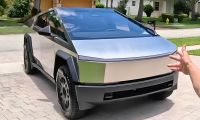A recent Reddit post requests help from a new Toyota Rav4 owner who finds that her rear hatch will not rise after pressing the liftgate cabin button.

While several comments directed her to her owner's manual, the owner eventually found a solution to the problem herself that did not require the manual's help. In fact, this is a useful and common response when anything electronic fails to respond appropriately: cutting off the power source, waiting a few minutes, and then powering it back on.
Which begs the question:
Why does unplugging or cutting off the power source and turning it back on sometimes reset malfunctioning electronics?
Temporary Faults Sometimes Need a Good Slapping
My old man was a TV repairman in the '60s when TVs were big wooden cabinets filled with vacuum tubes and weighed a couple of hundred pounds. Often, I would watch him with the innate criticism of a child as he diagnosed a problem, slapping the side of the cabinet and tapping vacuum tubes and other components with a pencil.
It wasn't until years afterward that I learned that his initial diagnostic technique was correct for the day and its technology. A good jostling or careful prodding can help locate the source of a problem.
This also works for mechanics…and therapists.
But I digress.
A Modern-Day Slapping That Works on Newer Technologies
The increasing complexity of modern cars has turned cars from purely mechanical creations into computers on wheels. The amount of chips put into a car outnumbers the gears in your drivetrain system. At the rate of change we are headed toward, it is no stretch of believability that chips will eventually outnumber the sum of all other components (including fasteners) that make a car what used to be a car.
Given that today's car is more computer-like than car-like, it is no surprise that the OP's problem was solved by simply shutting the system down and restarting it.
How often have you heard this tired refrain from your internet provider customer service rep about a connection problem over the phone: "Have you tried shutting down the computer and the modem/router, waiting a few minutes, and then rebooting the system?"
Every time. And it works the majority of the time.
And just because a car is new does not guarantee protection from electrical problems, as one Rav4 owner's parents discovered when he recently reported, "My Daughter's 2024 Toyota Hybrid RAV4 She Bought New At The Beginning Of December, Has Serious Electrical Issues."
The Reason and Power of a Hard Reset
Whether it is your internet connection, computer, or car, a hard reset can often resolve an electronic problem.
This is because it clears temporary faults and resets the device's internal state. Faults such as:
- Discharging Residual Electricity―Some electronic components, like capacitors and memory chips, retain residual charge even after being powered off. Removing power allows these components to fully discharge, clearing any corrupted temporary data or stuck states.
- Clearing Software or Firmware Glitches―Many devices run on firmware or software that can encounter errors, memory leaks, or unresponsive states. A power cycle forces the system to reboot from a clean slate, often resolving glitches.
- Resetting Internal Registers and Components―CPUs, sensors, and other electronic components can sometimes get stuck in an invalid state due to a power surge, static buildup, or an unexpected software crash. Cutting power forces them to reset to their default operational state.
- Reinitializing Peripherals and Connections―In network-like complex electronic pathways, components can get into a failed communication state. A power cycle forces them to re-establish connections properly.
- Clearing Overheating and Overcurrent Issues―Some devices go into a protective shutdown mode when they detect overheating or excessive current draw. Turning them off allows them to cool down, and restarting them can bring them back to normal operation.
In other words, simply powering down your car and restarting it can sometimes solve an electrical problem in your modern car.
Should this fail, however, please read your manual, ask questions, and understand that resets of your car's electrical glitch may require a trip to a garage with the proper scan/diagnostic tool to slap some sense into your recalcitrant computer on wheels.
For more electrical issues in cars you can DIY solve, here are two for your consideration:
- Easy Ford Explorer Electrical Problem Fix That Will Save You Thousands
- The DIY Car Repair Owners Fear and Do Wrong The Most
Timothy Boyer is an automotive reporter based in Cincinnati who currently researches and works on restoring older vehicles with engine modifications for improved performance. He also reports on modern cars (including EVs) with a focus on DIY mechanics, buying and using tools, and other related topical automotive repair news. Follow Tim on Twitter at @TimBoyerWrites as well as on Facebook and his automotive blog "Zen and the Art of DIY Car Repair" for useful daily news and topics related to new and used cars and trucks.
COMING UP NEXT: Tesla Cybertruck DIY PPF Batman Black In Just One Day, Says This Cybertruck Owner
Image Source: Deposit Photos











